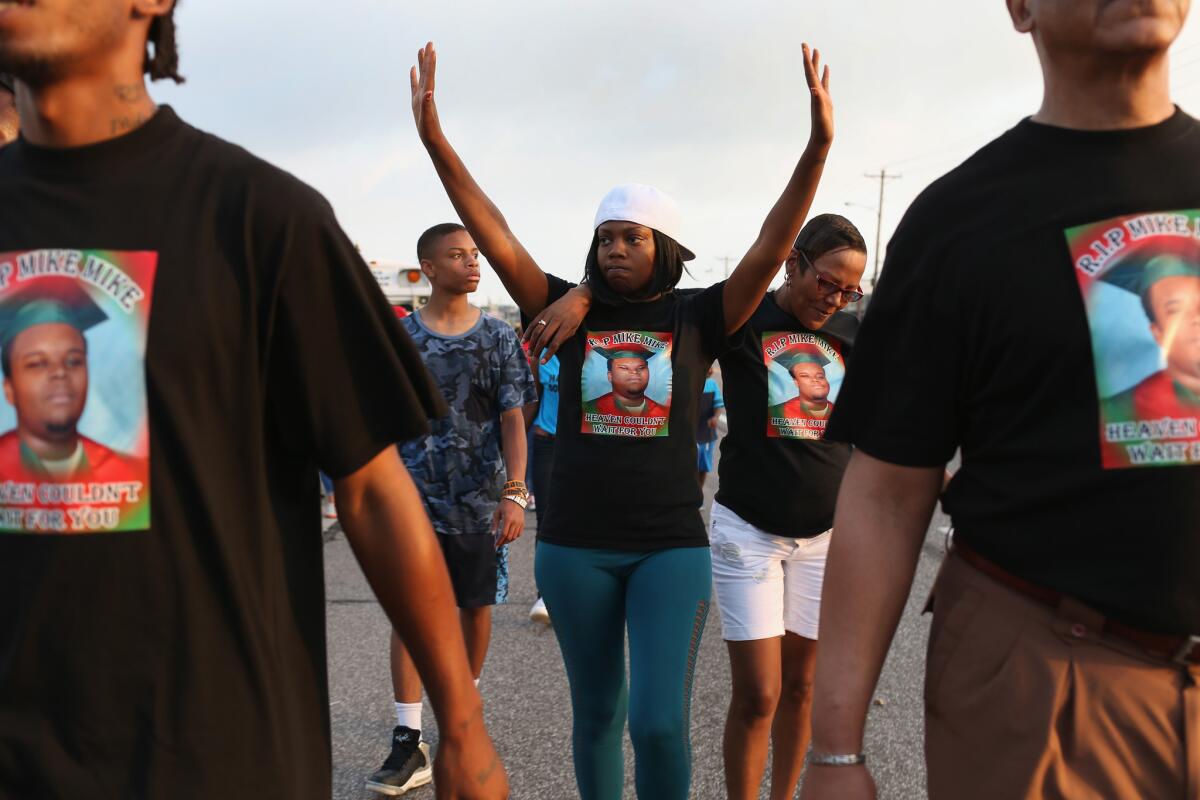Walking in Ferguson: If you’re black, it’s often against the law

- Share via
Reporting from FERGUSON, Mo. — Among the civil-rights violations alleged in a scathing Justice Department report on police in this St. Louis suburb, is one that African American residents say has long plagued them: “Manner of walking along roadway.”
The innocuous municipal code requires pedestrians to walk on the sidewalks or close to the side of the road whenever possible. Its intent is to make sure people don’t block a road.
But according to the federal report, police have routinely used the law for another purpose — to fine and harass blacks. African Americans accounted for 95% of manner of walking along roadway charges from 2011 to 2013, according to the report.
“We called it walking black,” said Kevin Seltzer, 30. “You would leave out of your house to go to the store and might not make it back.”
“They’ll stalk you and stop you,” he said. “They will say, ‘Hey, what’s your name? Got any warrants? Why are you strolling through the neighborhood? Come here, you look suspicious.’”
It was walking in a roadway that initiated the confrontation between Ferguson Police Officer Darren Wilson and 18-year-old Michael Brown on Aug. 9 — an event that ultimately sparked demonstrations across the country and prompted the Justice Department’s investigation of the Ferguson Police Department.
Brown was returning with a friend from a convenience store on West Florissant Avenue when Wilson stopped him for walking in the street. They argued and Wilson shot Brown in front of the Canfield Green apartment complex where he lived.
The Justice Department report found that citations for minor infractions, such as walking in the road, were all part of an effort by the city to increase revenue through fines. The municipal court can sentence a violator to up to three months in jail, a fine of up to $1,000 or both.
Spokesman Jeff Small said the city had no comment on allegations in the report that police abused or overused the charge to make money.
Susan McGraugh, a law professor at St. Louis University, said “manner of walking” laws have some similarities to “stop and frisk” policies of police in New York City and other locales.
Both are used by police as a way to “stop people to implicate them in a crime, harass them or stop them from being in the area,” she said.
She said the ‘manner of walking” ordinance in particular was “written in such a way as to be so vague it can be used at their discretion against people they want to harass” making it “ripe for abuse.”
Ferguson residents said the circumstances that led to Brown’s shooting were all too familiar.
On Thursday, Corbynn Marshall, 26, found himself walking the same route to the same store that Brown took the day he was killed.
As he hopscotched around icy patches on the sidewalk, Marshall, who is black, outlined his strategy for not getting stopped by police: He’s more alert as the weekend approaches because he believes there are more patrols.
There’s not much else he can do, he said, saying “it really is random. The chiefs tell them when to be lenient and strict.”
“They don’t think they’re going to get chastised or reprimanded,” said Marshall, who works as a dishwasher at the St. Louis Art Museum. “They need to realize the difference between policing the area and harassment.”
As he walked past the twin memorials on Canfield Drive where Brown was shot, Marshall said he always thinks the same two thoughts: “It didn’t have to happen, and when is it going to stop?”
Hakeem Ivery, 19, a black student at an alternative high school on West Florissant Avenue, said a Ferguson police officer stopped him for walking on Canfield Drive with friends last year because he looked like a suspect they were searching for in connection with a home invasion.
“He pulled me over right here and just said ‘Stand straight and look at the police car.’” Then, the officer said “Lock him up!”
He had an outstanding warrant for a traffic ticket and spent the night in jail. “They hop up on you, especially if you’re in a group — they’re like ‘Somebody in that group’s got a warrant.’ They want to make some money,” he said.
Seltzer said most black residents knew that just walking in the neighborhood could prompt a confrontation with a police officer.
“Certain things make you a target,” he said. “If you walk with a book bag you’re suspicious, if you’re walking slow — it’s stupid stuff.”
Women are not immune. Seltzer said he hesitated to send his girlfriend to the store for food, afraid she might get arrested.
“These are the type of decisions you have to make when you want a fountain soda or a bag of Doritos,” he said: “You have to decide if you want to spend the night in jail — or your girl.”
After Brown’s death, he said things got worse.
“There were guys who were afraid to walk down the street because they didn’t have an ID. The police, that’s just an excuse for them to take you in and fingerprint you,” he said.
Seltzer had a truck, and offered rides to fellow residents in exchange for gas money.
“People will pay $5 to go to the gas station just to avoid the police,” he said.
A neighbor who caught the bus to a local technical school would text him for a ride once he returned, or to let him know he made it home safe.
“It was like a buddy system,” Seltzer said, “not because of criminals, because of the police harassment.”
Protesters who arrived after Brown’s death were also charged with “manner of walking in roadway” or violating other city ordinances against loitering if they failed to keep moving on city streets.
Although police appear to have relaxed their enforcement in the wake of legal challenges, protesters this week discovered that they are still not immune.
Activist Jennifer McCoy, who is white, and three other women were arrested earlier this week while protesting in front of the Ferguson police department.
McCoy, 48, was charged with failure to disperse and failure to comply — two other charges questioned in the Justice Department report.
McCoy, who is also a lawyer, has been protesting since August and has been arrested once before but was still shocked.
She was held for several hours before being released on $300 bond. She talked with some officers at the jail before leaving.
“I really don’t think they understand they were infringing people’s rights,” she said. “They decide they’re going to arrest you, and then they make it a reality. They target someone who has disrespected them somehow and make the charge fit.”
Twitter: @mollyhf
More to Read
Sign up for Essential California
The most important California stories and recommendations in your inbox every morning.
You may occasionally receive promotional content from the Los Angeles Times.











